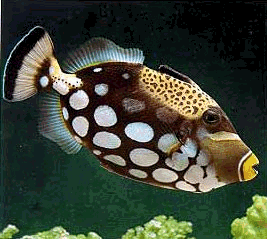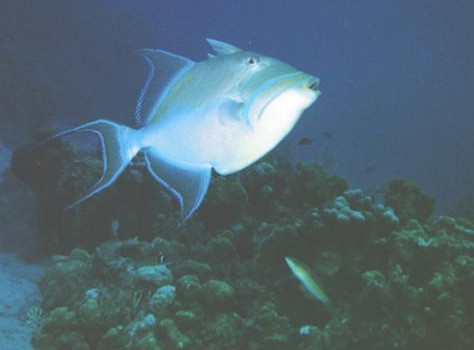
The thrill of keeping a Triggerfish in your home is extremely exciting. These fish become great pets, and are always a conversation piece. From their sometimes wild coloration, to their aggressive nature and size, they are the epitome of a saltwater fish-only tank. Theyíre from the family Balistidae. Most species are from shallow water. Hereís some things to keep in mind about them:

These fish are mostly very aggressive and will eat any small fish. In the wild, most eat: algae, sea urchins, coral, crabs, shrimp, brittlestar, sponges, tunicates, polycheate worms, cephalopods, hydrozoans and fish. In the aquarium, supply them with live fish,like Goldfish, Brine Shrimp, maybe some bloodworm for smaller ones, and a treat of clam meat or something of that nature. They are moderately hardy and well-lived. They can all become quite hand tame, but itís not recommended to feed them by hand at all.
Some Triggerfish will form a mutual relationship with small Gobies in the wild during certain parts of their life. On the reef, they are an important fish, as they consume the Crown of Thorns Starfish.
The min. size tank for most Triggers is over 100 gallons, seeing as how the average ones will get 14 inches in captivity eventually, and the tank would have to be at least 18 inches wide to accommodate that. A few can be kept in 75s though. Beware with Triggers, as you may have a specimen that will attain the upper limits of theirsize, around 20inches!

Triggers develop strange resting positions sometimes, like many larger Angelfish will. At night, they wedge themselves into the reefís crevices and use their fins (mainly the dorsal) to anchor them in place, like Firefish do.
Triggers are expensive (60$ range for med.). Always quarantine all saltwater fish for at least a couple weeks first. Try to get medium sized specimens ideally, they acclimate nicely. The Niger costs a bit less than most. Almost all species are readily available in the hobby. Always make sure theyíre eating in the store before purchase!
Triggerfish have a retractable dorsal fin. Their pectoral fins are very small and fairly useless, so they swim with their dorsal and anal fins the most. They are fairly poor swimmers, but good at ambushing.
Triggerfish dig pits and lay their eggs in them. Most Triggers will not guard the eggs, but the Mustache Triggerfish is and exception to the extreme, and will take on anything with its very sharp teeth to protect its eggs.

There are many species commonly seen in the trade. Here are some profiles:
The Niger Triggerfish, (Odonus niger), is also called the Black Triggerfish. It grows 10-20 inches, and 16 on average. Itís a rather peaceful carnivore and likes Goldfish. Some keep them in very specialized reef tanks. Theyíre from the Indo-Pacific.
The Pink-Tail Triggerfish is very aggressive.
The Clown Trigger is the coolest of the bunch. It grows 10-20 inches, and is from the Indo-Pacific. Itís very aggressive. The juvenile pattern is somewhat different from the adult in places.
The Undulated Trigger (Balistapus undulatus) is the most aggressive of the bunch, and slightly more reclusive. Itís from the Indo Pacific and grows 8-12 inches. It was discovered in 1797. The ones from the Indian Ocean have orange tails, while pacific ones have orange-rayed green tails
The Queen Triggerfish (B. vetula) is sometimes very aggressive, and is from the Tropical Western Atlantic. It grows 10-20 inches. Itís also called the Conchino or Peja Puerco sometimes.
The Bursa Trigger (a few Sci names) is less aggressive than some Triggers. They are from the Indo-Pacfici and grow 6-10 in. The males are larger and more colorful.
The Black-Finned Trigger (Melichthys ringens) is the most peaceful of the bunch. Itís also from the Indo-Pacific and grows 10-20 inches.
The Picasso Trigger (similar to the Humu Huma in looks, size, and aggression) grows 9-12inches, and is moderately aggressive. Itís from the Indo-Pacfiic and the Red Sea.
The only real good candidates for a specialized reef tank (no small fish, small shrimp, sea urchins, and other requirements) would be the Niger, that some people have kept in a reef, and the Bluethroat trigger (Xanthichthys auromarginatus). They should be the last ones introduced to the tank of course. Tangs and Rabbitfish would be ideal companions. Crustaceans, mollusks, and echinoderms will be eaten usually, along with small fish like Chromis. The only other one that could be considered is the Sargassum Trigger, (Xanthichthys sargassum) which is a more peaceful species. Triggers are very popular fish that have become a fish-only tank standard. They will provide years of enjoyment to the keeper. Thanks for educating yourself before purchase! The third Triggerfish Picture is from: http://www.nwlink.com/~alenkd/a/AE.html